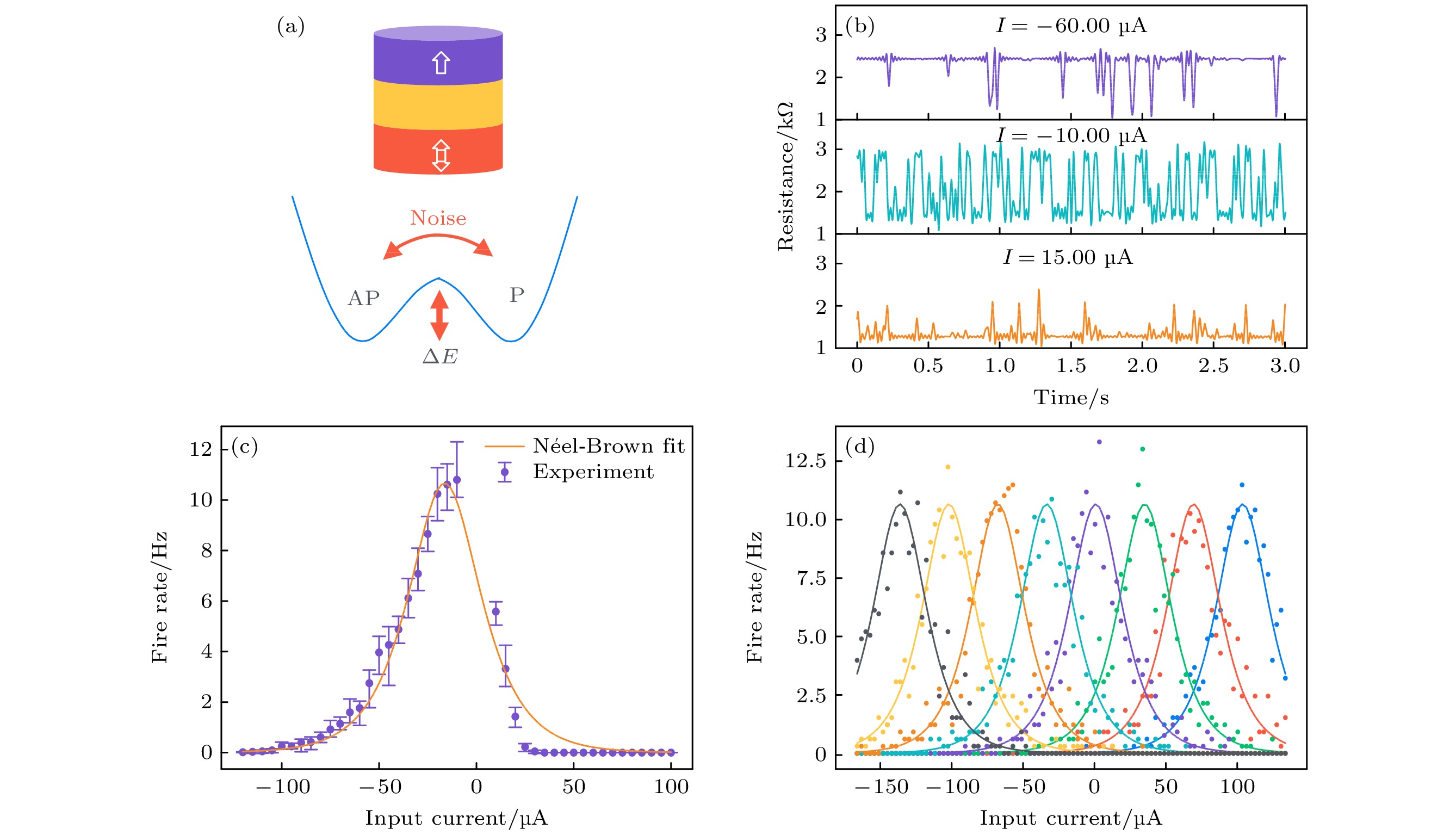-
Developing suitable algorithms that utilize the natural advantages of the corresponding devices is a key issue in the hardware research of brain-inspired computing. Population coding is one of the computational schemes in biological neural systems and it contains the mechanisms for noise reduction, short-term memory and implementation of complex nonlinear functions. Here we show the controllable stochastic dynamical behaviors for the technically mature spintronic device, magnetic tunnel junctions, which can be used as the basis of population coding. As an example, we construct a two-layer spiking neural network, in which groups of magnetic tunnel junctions are used to code input data. After unsupervised learning, this spiking neural network successfully classifies the iris data set. Numerical simulation demonstrates that the population coding is robust enough against the nonuniform dispersion in devices, which is inevitable in fabrication and integration of hardware devices.
-
Keywords:
- magnetic tunnel junction /
- population coding /
- spiking neural network /
- unsupervised learning
[1] LeCun Y, Bengio Y, Hinton G 2015 Nature 521 436
 Google Scholar
Google Scholar
[2] Roy K, Jaiswal A, Panda P 2019 Nature 575 607
 Google Scholar
Google Scholar
[3] Davies M, Srinivasa N, Lin T H, et al. 2018 IEEE Micro. 38 82
 Google Scholar
Google Scholar
[4] Pei J, Deng L, Song S, et al. 2019 Nature 572 106
 Google Scholar
Google Scholar
[5] Ambrogio S, Narayanan P, Tsai H, Shelby R M, Boybat I, di Nolfo C, Sidler S, Giordano M, Bodini M, Farinha N C P, Killeen B, Cheng C, Jaoudi Y, Burr G W 2018 Nature 558 60
 Google Scholar
Google Scholar
[6] Torrejon J, Riou M, Araujo F A, et al. 2017 Nature 547 428
 Google Scholar
Google Scholar
[7] Yao P, Wu H Q, Gao B, Tang J S, Zhang Q T, Zhang W Q, Yang J J, Qian H 2020 Nature 577 641
 Google Scholar
Google Scholar
[8] Zhang X M, Zhuo Y, Luo Q, et al. 2020 Nat. Commun. 11 51
 Google Scholar
Google Scholar
[9] Zhang Y, Wang Z R, Zhu J D, Yang Y C, Rao M Y, Song W H, Zhuo Y, Zhang X M, Cui M L, Shen L L, Huang R, Yang J J 2020 Appl. Phys. Rev. 7 011308
 Google Scholar
Google Scholar
[10] Jung S, Lee H, Myung S, et al. 2022 Nature 601 211
 Google Scholar
Google Scholar
[11] Grollier J, Querlioz D, Camsari K Y, Everschor-Sitte K, Fukami S, Stiles M D 2020 Nat. Electron. 3 360
 Google Scholar
Google Scholar
[12] Lan X K, Cao Y, Liu X Y, Xu K J, Liu C, Zheng H Z, Wang K Y 2021 Adv. Intell. Syst. 3 2000182
 Google Scholar
Google Scholar
[13] Jiang W C, Chen L N, Zhou K Y, Li L Y, Fu Q W, Du Y W, Liu R H 2019 Appl. Phys. Lett. 115 192403
 Google Scholar
Google Scholar
[14] Zhang Y J, Zheng Q, Zhu X R, Yuan Z, Xia K 2020 Sci. China Phys. Mech. Astron. 63 277531
 Google Scholar
Google Scholar
[15] Zheng Q, Mi Y Y, Zhu X R, Yuan Z, Xia K 2020 Phys. Rev. Appl. 14 044060
 Google Scholar
Google Scholar
[16] Zheng Q, Zhu X R, Mi Y Y, Yuan Z, Xia K 2020 AIP Adv. 10 025116
 Google Scholar
Google Scholar
[17] Sengupta A, Roy K 2016 Phys. Rev. Appl. 5 024012
 Google Scholar
Google Scholar
[18] Yu W C, Xiao J, Bauer G E W 2021 Phys. Rev. B 104 L180405
 Google Scholar
Google Scholar
[19] Song K M, Jeong J S, Pan B, et al. 2020 Nat. Electron. 3 148
 Google Scholar
Google Scholar
[20] Kurenkov A, DuttaGupta S, Zhang C, Fukami S, Horio Y, Ohno H 2019 Adv. Mater. 31 e1900636
 Google Scholar
Google Scholar
[21] Romera M, Talatchian P, Tsunegi S, et al. 2018 Nature 563 230
 Google Scholar
Google Scholar
[22] Banino A, Barry C, Uria B, et al. 2018 Nature 557 429
 Google Scholar
Google Scholar
[23] Mi Y, Katkov M, Tsodyks M 2017 Neuron 93 323
 Google Scholar
Google Scholar
[24] Pouget A, Dayan P, Zemel R 2000 Nat. Rev. Neurosci. 1 125
 Google Scholar
Google Scholar
[25] Thakur C S, Wang R, Hamilton T J, Tapson J, van Schaik A 2016 IEEE Transactions on Circuits and Systems I: Regular Papers 63 211
 Google Scholar
Google Scholar
[26] Tuma T, Pantazi A, Le Gallo M, Sebastian A, Eleftheriou E 2016 Nat. Nanotechnol. 11 693
 Google Scholar
Google Scholar
[27] Mizrahi A, Hirtzlin T, Fukushima A, Kubota H, Yuasa S, Grollier J, Querlioz D 2018 Nat. Commun. 9 1533
 Google Scholar
Google Scholar
[28] Cai J L, Fang B, Zhang L K, Lv W X, Zhang B S, Zhou T J, Finocchio G, Zeng Z M 2019 Phys. Rev. Appl. 11 034015
 Google Scholar
Google Scholar
[29] Cai K M, Yang M Y, Ju H L, et al. 2017 Nat. Mater. 16 712
 Google Scholar
Google Scholar
[30] Li Z, Zhang S 2004 Phys. Rev. B 69 134416
 Google Scholar
Google Scholar
[31] Diehl P U, Cook M 2015 Front. Comput. Neurosci. 9 99
 Google Scholar
Google Scholar
[32] Fisher R A 1936 Annals of Eugenics 7 179
 Google Scholar
Google Scholar
[33] Dayan P, Abbott L F 2001 Theoretical Neuroscience (Cambridge, MA: MIT Press) pp108–112
[34] Biswas A, Prasad S, Lashkare S, Ganguly U 2016 arXiv: 1612.02233
[35] Hayakawa K, Kanai S, Funatsu T, Igarashi J, Jinnai B, Borders W A, Ohno H, Fukami S 2021 Phys. Rev. Lett. 126 117202
 Google Scholar
Google Scholar
-
图 1 (a) 磁性隧道结示意图; (b) 不同电流下磁性隧道结电阻随时间的变化; (c) 磁性隧道结翻转频率与电流的函数关系; (d) 一组存在不同偏置电流的隧道结实现群体编码 (散点为Néel-Brown理论仿真结果, 实线对应隧道结的调谐曲线)
Fig. 1. (a) Schematic of a magnetic tunnel junction; (b) measured electrical resistance of a magnetic tunnel junction as a function of time under different electrical currents; (c) switching frequency of a magnetic tunnel junction as a function of electrical current; (d) population coding using a group of magnetic tunnel junctions with different bias currents (The dots are simulated data using the Néel-Brown theory and the solid lines are the corresponding tuning curves).
图 2 (a) 群体编码脉冲神经网络示意图; (b) 网络训练过程示意图; (c) 鸢尾花数据集无监督聚类测试结果; (d) 用于编码一个数据的隧道结数目与输出神经元数量对网络聚类正确率的影响
Fig. 2. (a) Schematic of spiking neural network; (b) schematic illustration of the network learning process; (c) test results of the unsupervised classification of the iris data set; (d) the influence of number of magnetic tunnel junctions used in the population coding and number of output neurons.
-
[1] LeCun Y, Bengio Y, Hinton G 2015 Nature 521 436
 Google Scholar
Google Scholar
[2] Roy K, Jaiswal A, Panda P 2019 Nature 575 607
 Google Scholar
Google Scholar
[3] Davies M, Srinivasa N, Lin T H, et al. 2018 IEEE Micro. 38 82
 Google Scholar
Google Scholar
[4] Pei J, Deng L, Song S, et al. 2019 Nature 572 106
 Google Scholar
Google Scholar
[5] Ambrogio S, Narayanan P, Tsai H, Shelby R M, Boybat I, di Nolfo C, Sidler S, Giordano M, Bodini M, Farinha N C P, Killeen B, Cheng C, Jaoudi Y, Burr G W 2018 Nature 558 60
 Google Scholar
Google Scholar
[6] Torrejon J, Riou M, Araujo F A, et al. 2017 Nature 547 428
 Google Scholar
Google Scholar
[7] Yao P, Wu H Q, Gao B, Tang J S, Zhang Q T, Zhang W Q, Yang J J, Qian H 2020 Nature 577 641
 Google Scholar
Google Scholar
[8] Zhang X M, Zhuo Y, Luo Q, et al. 2020 Nat. Commun. 11 51
 Google Scholar
Google Scholar
[9] Zhang Y, Wang Z R, Zhu J D, Yang Y C, Rao M Y, Song W H, Zhuo Y, Zhang X M, Cui M L, Shen L L, Huang R, Yang J J 2020 Appl. Phys. Rev. 7 011308
 Google Scholar
Google Scholar
[10] Jung S, Lee H, Myung S, et al. 2022 Nature 601 211
 Google Scholar
Google Scholar
[11] Grollier J, Querlioz D, Camsari K Y, Everschor-Sitte K, Fukami S, Stiles M D 2020 Nat. Electron. 3 360
 Google Scholar
Google Scholar
[12] Lan X K, Cao Y, Liu X Y, Xu K J, Liu C, Zheng H Z, Wang K Y 2021 Adv. Intell. Syst. 3 2000182
 Google Scholar
Google Scholar
[13] Jiang W C, Chen L N, Zhou K Y, Li L Y, Fu Q W, Du Y W, Liu R H 2019 Appl. Phys. Lett. 115 192403
 Google Scholar
Google Scholar
[14] Zhang Y J, Zheng Q, Zhu X R, Yuan Z, Xia K 2020 Sci. China Phys. Mech. Astron. 63 277531
 Google Scholar
Google Scholar
[15] Zheng Q, Mi Y Y, Zhu X R, Yuan Z, Xia K 2020 Phys. Rev. Appl. 14 044060
 Google Scholar
Google Scholar
[16] Zheng Q, Zhu X R, Mi Y Y, Yuan Z, Xia K 2020 AIP Adv. 10 025116
 Google Scholar
Google Scholar
[17] Sengupta A, Roy K 2016 Phys. Rev. Appl. 5 024012
 Google Scholar
Google Scholar
[18] Yu W C, Xiao J, Bauer G E W 2021 Phys. Rev. B 104 L180405
 Google Scholar
Google Scholar
[19] Song K M, Jeong J S, Pan B, et al. 2020 Nat. Electron. 3 148
 Google Scholar
Google Scholar
[20] Kurenkov A, DuttaGupta S, Zhang C, Fukami S, Horio Y, Ohno H 2019 Adv. Mater. 31 e1900636
 Google Scholar
Google Scholar
[21] Romera M, Talatchian P, Tsunegi S, et al. 2018 Nature 563 230
 Google Scholar
Google Scholar
[22] Banino A, Barry C, Uria B, et al. 2018 Nature 557 429
 Google Scholar
Google Scholar
[23] Mi Y, Katkov M, Tsodyks M 2017 Neuron 93 323
 Google Scholar
Google Scholar
[24] Pouget A, Dayan P, Zemel R 2000 Nat. Rev. Neurosci. 1 125
 Google Scholar
Google Scholar
[25] Thakur C S, Wang R, Hamilton T J, Tapson J, van Schaik A 2016 IEEE Transactions on Circuits and Systems I: Regular Papers 63 211
 Google Scholar
Google Scholar
[26] Tuma T, Pantazi A, Le Gallo M, Sebastian A, Eleftheriou E 2016 Nat. Nanotechnol. 11 693
 Google Scholar
Google Scholar
[27] Mizrahi A, Hirtzlin T, Fukushima A, Kubota H, Yuasa S, Grollier J, Querlioz D 2018 Nat. Commun. 9 1533
 Google Scholar
Google Scholar
[28] Cai J L, Fang B, Zhang L K, Lv W X, Zhang B S, Zhou T J, Finocchio G, Zeng Z M 2019 Phys. Rev. Appl. 11 034015
 Google Scholar
Google Scholar
[29] Cai K M, Yang M Y, Ju H L, et al. 2017 Nat. Mater. 16 712
 Google Scholar
Google Scholar
[30] Li Z, Zhang S 2004 Phys. Rev. B 69 134416
 Google Scholar
Google Scholar
[31] Diehl P U, Cook M 2015 Front. Comput. Neurosci. 9 99
 Google Scholar
Google Scholar
[32] Fisher R A 1936 Annals of Eugenics 7 179
 Google Scholar
Google Scholar
[33] Dayan P, Abbott L F 2001 Theoretical Neuroscience (Cambridge, MA: MIT Press) pp108–112
[34] Biswas A, Prasad S, Lashkare S, Ganguly U 2016 arXiv: 1612.02233
[35] Hayakawa K, Kanai S, Funatsu T, Igarashi J, Jinnai B, Borders W A, Ohno H, Fukami S 2021 Phys. Rev. Lett. 126 117202
 Google Scholar
Google Scholar
计量
- 文章访问数: 7095
- PDF下载量: 277
- 被引次数: 0














 下载:
下载:



